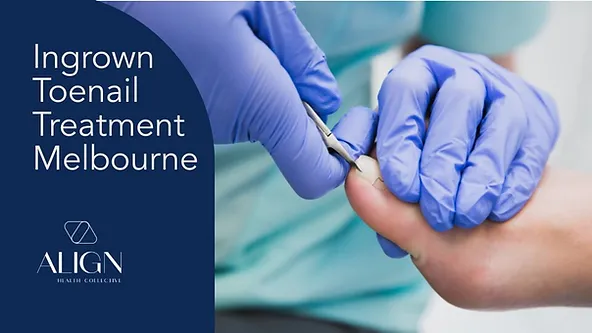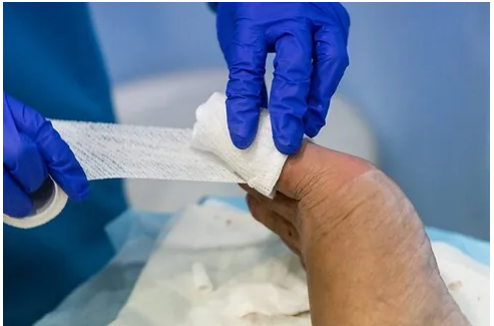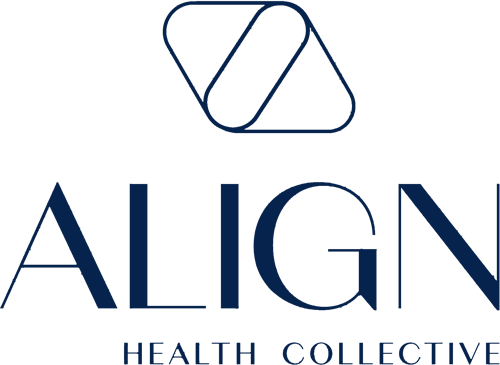Do you suffer from an ingrown toenail and need a Melbourne podiatry clinic for treatment options? Don’t worry, you’re not alone. Fortunately, there are effective treatments available that can relieve your symptoms, prevent complications, and, where necessary, stop the offending nail from regrowing and causing further problems.
At Align Health Collective in Melbourne, Victoria, we provide comprehensive podiatry care for ingrown toenails. Our experienced podiatrists offer personalised treatment options, including conservative management techniques and minor surgical procedures to alleviate your symptoms and get you back on your feet.

What are Ingrown Toenails?
Ingrown toenails are a common condition where the edge of the toenail grows into the surrounding skin, causing pain and discomfort in and around one or both sides of the nail. They can affect any toe, but usually occur in the big toe.
Ingrown toenails can be classified as mild, moderate, or severe. Mild cases may only require at-home remedies and proper nail care to alleviate symptoms. However, severe ingrowing toenails may require nail surgery or a course of antibiotics to prevent further complications.
Ingrown toenails often get worse over time, so it’s important to consult a qualified health professional for diagnosis and treatment as soon as possible.
Causes of Ingrown Toenails
Ingrown toenails can affect anyone, however, there are several factors that can increase your risk of developing this painful condition:
- Poor nail cutting technique, such as cutting toenails too short, not cutting straight across, or rounding the edges
- Wearing shoes and/or socks that are too narrow, too tight, or put pressure on the toes
- Toenail injuries, such as stubbing your toe or trauma caused by dropping a heavy object on your toenail
- Having nails that are abnormally curved or thickened due to genetic factors, making it more likely for nails to grow into the skin
- Participating in sports and activities that are likely to cause toenail injuries such as ballet, gymnastics, football, tennis, and running
- Medical conditions that affect the feet, such as diabetes, poor blood circulation, or peripheral arterial disease.
When to See a Podiatrist for an Ingrown Toenail
Ingrown toenails can be an extremely painful and uncomfortable condition, but early intervention can prevent complications and promote healthy nail growth. The following list includes some of the very common ingrown toenail symptoms. Your experience with these symptoms can range from mild discomfort to excruciating pain. It’s important to note that if you’re experiencing any of these symptoms, you should consult a Kew podiatrist or general practitioner (GP) as soon as possible. The longer you wait, the worse your pain and symptoms will get.
- Pain and tenderness around the nail: Ingrown toenails can cause pain and tenderness around the affected nail. The pain will usually increase when pressure is applied, which can also be a result of your shoes pressing on the affected area.
- Redness and swelling: As the nail grows back into the skin, you may notice redness and swelling around the corners and sides of the nail.
- Inflammation or infection: In some moderate and severe cases, an ingrown toenail can become infected. A toenail infection can lead to inflammation, an abscess, throbbing pain, pus, and/or discharge.
- Difficulty walking or wearing shoes: The increased pressure on the affected toenail can make it difficult to walk or wear shoes without pain or discomfort, limiting your mobility and making everyday activities difficult.
- Abnormal nail growth: The nail may appear distorted, which can be caused by an ingrowing nail, but can also be indirectly caused by a toenail fungus.
Treatment Options for Ingrown Toenails
There are several treatment options available for treating ingrown toenails as well as alleviating associated pain and symptoms. Your podiatrist will examine your toenails and advise treatment that can range from conservative management techniques to surgical procedures.
Conservative Management Techniques
Conservative management techniques are non-surgical methods of treating ingrown toenails. These techniques may include soaking the affected toe in warm, salty water, wearing open-toed shoes, keeping the feet and affected toenail clean and dry, limiting exercise and sweat, or applying antibiotic ointment to prevent infection. In some cases, your podiatrist may also recommend using a wedge to lift the nail away from the skin and encourage proper growth.
Surgical Treatment for Ingrown Toenails
For more severe cases, where conservative management techniques have been ineffective, your podiatrist may recommend a minor ingrown toenail surgery procedure known as partial nail avulsion (PNA) or wedge resection.
This is a very common procedure that all podiatrists are very familiar with. PNA will remove the offending portion of the nail, related tissue, and/or nail bed.
Your podiatrist may also recommend chemical matrixectomy, which targets both the nail and matrix will prevent regrowth of the nail. When PNA is done without chemical matrixectomy, the nail will grow back, but most likely in a straighter, healthier direction.
PNA is performed under local anaesthesia to ensure you have a painless experience, and you may also be prescribed antibiotics to prevent infection. You can expect to be back on your feet and return to your daily activities within a few days.
Your podiatrist Oakleigh will provide you with aftercare and post-procedure instructions to make sure you heal quickly and thoroughly, and to ensure that you don’t experience any further complications or pain.
For very severe cases, your podiatrist may recommend total nail avulsion, where the entire nail is removed. This treatment works as an effective last resort, and would usually only be recommended if a recurrent ingrown toenail has not responded well to any other treatment.
Recovery for Surgical Treatment of Ingrown Toenails
Here are some aftercare and recovery tips to help you manage the healing process after surgical treatment for an ingrown toenail:
- Follow your podiatrist’s instructions carefully
- Keep your toes clean and dry to prevent infection
- Take prescribed medication as directed by your qualified healthcare professional
- Elevate your foot above chest level to reduce swelling
- Wear comfortable, supportive shoes to avoid further irritation – open-toed shoes are a good option
- Follow up with your podiatrist to monitor any potential complications.

Seeing a Podiatrist vs. Home Treatment
Not sure if you should see a podiatrist? Have a look at the comparison table below and decide if treatment with a podiatrist is the right option for you.
| | At Home | Podiatrist |
| Diagnosis | Difficult to diagnose accurately | Can accurately diagnose the root cause and severity |
| Pain and Discomfort | Limited pain relief options | Offers professional treatment to alleviate pain and discomfort |
| Potential Complications | Increased risk of complications if left untreated | Delivers professional treatment that can prevent complications and promote healthy nail growth |
| Treatment Options | Limited treatment options | Provides a range of customised treatment options |
| Expert Care | Limited knowledge and expertise | Trained experts in foot health with experience in safe and effective treatment |
Preventing Ingrown Toenails
Preventing ingrown toenails is easier than treating them. Here are our top tips on how to prevent ingrown toenails from recurring:
- Choose footwear that fits properly and allows enough space for toe movement.
- Practise proper nail care:
- Cut toenails straight across
- Don’t cut toenails too short or deep on the sides
- Don’t file the edges down.
- If you are prone to ingrown toenails, consider regular nail care with a podiatrist.
- Seek treatment for symptoms as soon as possible. This will reduce the risk of complications so you can return to your daily activities quickly.
Get in Touch
At Align Health Collective in Melbourne, VIC, we understand how painful ingrown toenails can be, which is why our dedicated podiatrists will ensure the highest level of care and support throughout your consultation, diagnosis, and treatment.
We strongly believe in providing effective care that ensures long-term relief from your symptoms. Moreover, we focus on delivering individualised treatment plans targeted at your unique needs. Contact us today to schedule a consultation and take the first step towards healing and getting back on your feet, pain free.
Ingrown Toenail FAQs
How much does it cost to remove an ingrown toenail in Melbourne?
The cost will depend on the type of treatment you require as well as your insurance cover, however, we do offer bulk billing. With a referral from a GP, you are eligible for five bulk billed allied health visits per year.
How do you fix an ingrown toenail?
Podiatrists use a range of conservative management techniques, or it may be necessary for your podiatrist to perform a minor procedure called partial nail avulsion. This is a common, minor surgery to remove the affected area of an ingrown toenail. It is performed under local anaesthetic.
Can I cut an ingrown toenail myself?
You definitely shouldn’t cut an ingrown toenail yourself. This can develop further complications, more pain, and infections. You should seek professional treatment from a podiatrist or qualified healthcare professional.
Related Posts:

